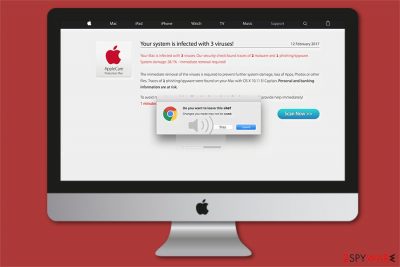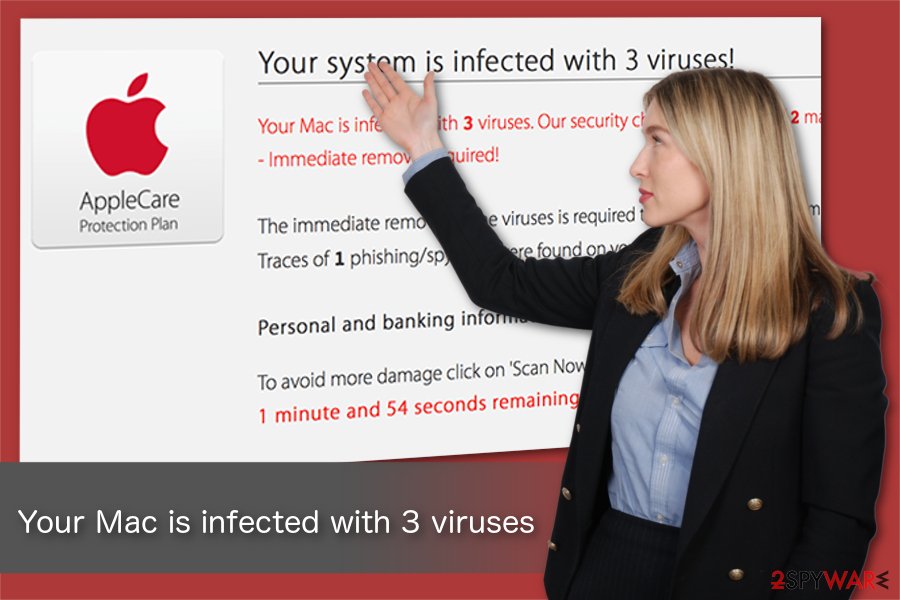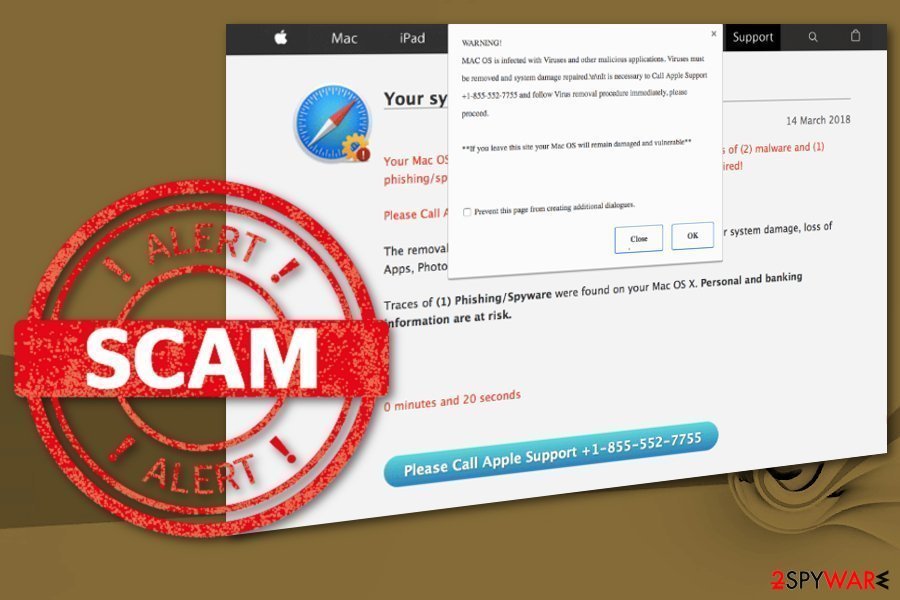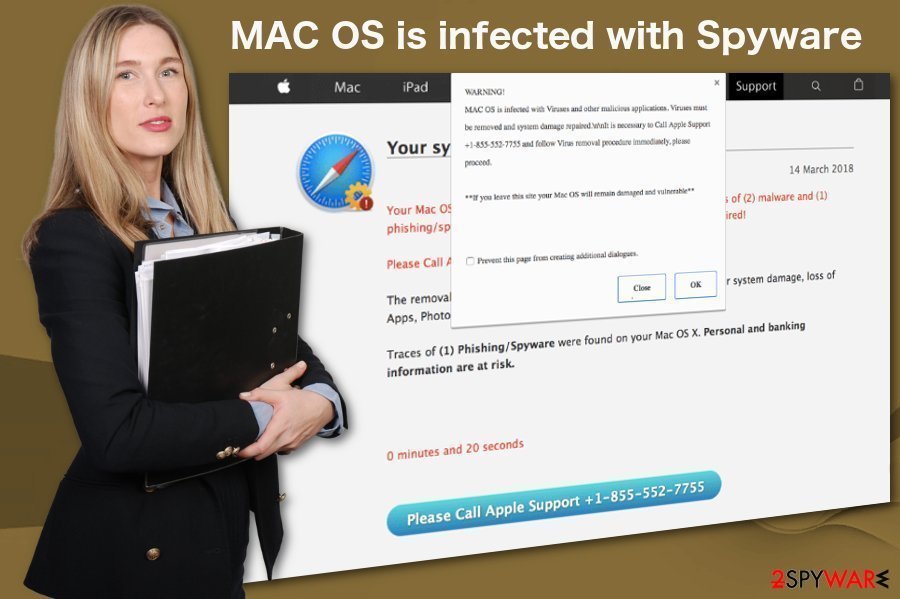Your Mac is infected with 3 viruses (scam) - fake
Your Mac is infected with 3 viruses Removal Guide
What is Your Mac is infected with 3 viruses?
Your system is infected with (3) viruses is a fake Safari pop-up urging users to scan Mac to prevent the loss of personal information

Your system is infected with (3) viruses is a scam message which pops up during your browsing sessions to “inform” the victim about 2 malware and 1 spyware infection found on the device. Thus, users are urged to perform a system scan if they want to protect their personal and banking data. Keep in mind that this is a Mac scam designed to either infiltrate it with potentially dangerous software or trick people into giving sensitive information to the scammers.
This tech support scam[1] encourages people to use the provided phone number to contact Apple support which is obviously fake. People behind it have nothing to do with Apple, and calling these numbers can lead victims to more significant damage.
The phishing scam messages occur when the browser is active and information about threats appears alongside the Apple Support number that should be called if the user wants to remove all those viruses. However, this is not related to any threats and real security issues.
If you run across a particular warning, make sure to ignore it and move on to system cleaning processes. Visiting any redirect sites can lead to insecure sites filled with malware. Also, calling the provided number or contacting criminals in any way can result in serious issues either with your device or privacy and security of information.
| Name | Your system is infected with 3 viruses |
|---|---|
| Type | Malware, fake pop-ups caused by adware |
| other versions |
|
| Distribution | Software bundles |
| Symptoms | Adware program starts delivering fake virus alerts which pop up in a new window and prompt to scan the PC |
| Potential dangers | Users can be tricked to submit credit card details and/or install malicious programs |
| Elimination | The scam can be seen on an infected website. Additionally, it can be caused by an adware virus hiding in the system. Once you get rid of it, use FortectIntego to fix the system entirely and avoid system errors hailing from corrupted files. |
Usually, the pop-up is delivered by an adware[2] program. You can get infected with one via software-bundles if you do not pay close attention during the installation of freeware. The false message appears in a new window and displays the following warning:
Your system is infected with 3 viruses!
Your Mac is infected with 3 viruses. Our security check found traces of 2 malware and 1 phishing/spyware.
System damage: 28.1% – immediate removal required!
The immediate removal of the viruses is required to prevent further system damage, loss of Apps, Photos or other files. Traces of 1 phishing/spyware were found on your Mac with OS X High Sierra. Personal and banking information are at risk.To avoid more damage click on 'Scan Now' immediately. Our deep scan will provide help immediately!
Scammers behind the fake warning are motivated to gain illegal revenue from this fake alert. Likewise, they can ask you to submit your personal information if you proceed and click on the “Scan now >>” button displayed in the bottom-right corner of the window.

The pop-up message of the second scam reads the following:
WARNING!
MAC OS is infected with Spyware and other malicious applications.
Spyware must be removed and system damage repaired.
It is necessary to Call Apple Support +1-844-295-3111 and follow Virus removal procedures immediately, please proceed.
** If you leave this site your Mac OS will remain damaged and vulnerable**
The removal of (3) Spyware is required immediately to prevent further system damage, loss of Apps, Photos and other files.
Traces if (1) Phishing/Spyware were found on your Mac OS X. Personal and banking information are at risk.
After Apple presented Mojave OS, scammers released the following scam which is almost identical to the previous ones:
Your Mojave is infected with (3) viruses!
Your Mojave is infected with (3) viruses. Our security check found traces of 2 malware and 1 phishing/spyware. System damage: 28.1% – Immediate removal required!
The immediate removal of the viruses is required to prevent further system damage, loss of Apps, Photos or other files. Traces of 1 phishing/spyware were found on your Mojave with.
Personal and banking information are at risk.
To avoid more damage click on 'Scan Now' immediately. Our deep scan will provide help immediately!
4 minutes and seconds 52 remaining before damage is permanent.
Note that this message is fake and you should not agree to perform the system scan. Keep in mind that criminals try to make the scam look convincing. Thus, it's easy to get tricked as they claim that the user must scan their computers immediately if they do not want to lose the following data:
- Banking details;
- Apps;
- Photos;
- Other files.
However, we can assure you that your computer is safe you should never fall into the trap of scammers. Instead, you can remove adware and check your device for other cyber threats using a reliable antivirus. This way, you will not be tricked to install fake security programs or even malware.
We advise using FortectIntego for preventing any issues related to system changes caused by the scam. However, for Your system is infected with 3 viruses removal, you need to get rid of every adware-type virus that could be related to this scam.
Unfortunately, there are numerous ad-supported threats that could cause this fake error, so make sure you opt for a full system scan instead of going thru your PC system manually. Note, that there are alternative ways how you can get rid of this fake pop-up as well. They are presented at the end of this article.

Mac OS is infected with Spyware – yet another version of this tech support scam
MAC OS is infected with Spyware is yet another error message displayed on the system by cybercriminals. It is stating about possible malware infections and offering to contact Apple support.
The error message indicates that there is adware on your system that causes these issues and redirects you to websites filled with commercial content. Those advertisements cause redirects to rogue sites where this scam message is displayed.
Be aware that this alert about spyware and malware danger is fake and your device is probably safe, the only infection is this potentially unwanted program that delivers intrusive ads to you.
You must remove adware from the system immediately because such programs can also track users' information. An IP address, location, browsing habits, and search preferences can be accessed immediately after infiltration without any additional malware tools.

Your Mac Might Be Infected is seeking the same aim – to trick users into dialing fake support numbers
Your Mac might be infected message is an identical scam mostly displayed on the Safari web browser. It resembles the official Apple background and can easily lure people into calling the questionable number. This scam message can easily affect other browsers, so you need to clean the system further and remove all changes the related adware has initiated on your system.
People disguised as Apple employees are seeking certain things:
- get the remote access on the device;
- install malicious programs (like keyloggers or trojans);
- swindle the money for the invented service;
- steal financial and personal information.
Make sure you remove “Your Mac might be infected” virus right after it starts interrupting you. You should never call these given numbers because people behind the “support” team have one goal – to lure your money or steal credit information, logins and passwords.
Prevent scams by paying attention during the installation of freeware
You can encounter fake virus scan alerts if your system is infected with an ad-supported program. This software is designed to deliver commercial content and scam messages for malevolent purposes. Adware is distributed by employing a well-known marketing technique called bundling.
In other terms, these potentially unwanted programs (PUPs)[3] are installed as additional components with freeware. If users rush through the installation procedure and choose Quick or Recommended settings, they are unable to detect the adware which comes together.
Therefore, it is essential to be cautious when installing freeware — pick Custom or Advanced mode of the installer and search for suspicious pre-selected elements. Make sure you uncheck those marks and run a full system scan to ensure that none of the PUPs managed to get through.
Uninstall suspicious pieces from the machine
- From the menu bar, select Go > Applications.
- In the Applications folder, look for all related entries.
- Click on the app and drag it to Trash (or right-click and pick Move to Trash)
![Uninstall from Mac 1 Uninstall from Mac 1]()
To fully remove an unwanted app, you need to access Application Support, LaunchAgents, and LaunchDaemons folders and delete relevant files:
- Select Go > Go to Folder.
- Enter /Library/Application Support and click Go or press Enter.
- In the Application Support folder, look for any dubious entries and then delete them.
- Now enter /Library/LaunchAgents and /Library/LaunchDaemons folders the same way and terminate all the related .plist files.
![Uninstall from Mac 2 Uninstall from Mac 2]()
Stop the scam messages from showing up on your browser
The easiest way to remove adware from the device is to get a professional malware removal tool. It will only take you several minutes before the security software identifies and adware and cleans your Mac from potentially unwanted programs or other cyber threats.
However, manual Your Mac is infected with 3 viruses removal is also an option. Elimination guidelines that can help you complete the procedure are presented below. Although, Virusi.bg[4] team suggests uninstalling the adware automatically as it is a safer method.
You may remove virus damage with a help of FortectIntego. SpyHunter 5Combo Cleaner and Malwarebytes are recommended to detect potentially unwanted programs and viruses with all their files and registry entries that are related to them.
Getting rid of Your Mac is infected with 3 viruses. Follow these steps
Remove from Microsoft Edge
Delete unwanted extensions from MS Edge:
- Select Menu (three horizontal dots at the top-right of the browser window) and pick Extensions.
- From the list, pick the extension and click on the Gear icon.
- Click on Uninstall at the bottom.

Clear cookies and other browser data:
- Click on the Menu (three horizontal dots at the top-right of the browser window) and select Privacy & security.
- Under Clear browsing data, pick Choose what to clear.
- Select everything (apart from passwords, although you might want to include Media licenses as well, if applicable) and click on Clear.

Restore new tab and homepage settings:
- Click the menu icon and choose Settings.
- Then find On startup section.
- Click Disable if you found any suspicious domain.
Reset MS Edge if the above steps did not work:
- Press on Ctrl + Shift + Esc to open Task Manager.
- Click on More details arrow at the bottom of the window.
- Select Details tab.
- Now scroll down and locate every entry with Microsoft Edge name in it. Right-click on each of them and select End Task to stop MS Edge from running.

If this solution failed to help you, you need to use an advanced Edge reset method. Note that you need to backup your data before proceeding.
- Find the following folder on your computer: C:\\Users\\%username%\\AppData\\Local\\Packages\\Microsoft.MicrosoftEdge_8wekyb3d8bbwe.
- Press Ctrl + A on your keyboard to select all folders.
- Right-click on them and pick Delete

- Now right-click on the Start button and pick Windows PowerShell (Admin).
- When the new window opens, copy and paste the following command, and then press Enter:
Get-AppXPackage -AllUsers -Name Microsoft.MicrosoftEdge | Foreach {Add-AppxPackage -DisableDevelopmentMode -Register “$($_.InstallLocation)\\AppXManifest.xml” -Verbose

Instructions for Chromium-based Edge
Delete extensions from MS Edge (Chromium):
- Open Edge and click select Settings > Extensions.
- Delete unwanted extensions by clicking Remove.

Clear cache and site data:
- Click on Menu and go to Settings.
- Select Privacy, search and services.
- Under Clear browsing data, pick Choose what to clear.
- Under Time range, pick All time.
- Select Clear now.

Reset Chromium-based MS Edge:
- Click on Menu and select Settings.
- On the left side, pick Reset settings.
- Select Restore settings to their default values.
- Confirm with Reset.

Remove from Mozilla Firefox (FF)
Remove dangerous extensions:
- Open Mozilla Firefox browser and click on the Menu (three horizontal lines at the top-right of the window).
- Select Add-ons.
- In here, select unwanted plugin and click Remove.

Reset the homepage:
- Click three horizontal lines at the top right corner to open the menu.
- Choose Options.
- Under Home options, enter your preferred site that will open every time you newly open the Mozilla Firefox.
Clear cookies and site data:
- Click Menu and pick Settings.
- Go to Privacy & Security section.
- Scroll down to locate Cookies and Site Data.
- Click on Clear Data…
- Select Cookies and Site Data, as well as Cached Web Content and press Clear.

Reset Mozilla Firefox
If clearing the browser as explained above did not help, reset Mozilla Firefox:
- Open Mozilla Firefox browser and click the Menu.
- Go to Help and then choose Troubleshooting Information.

- Under Give Firefox a tune up section, click on Refresh Firefox…
- Once the pop-up shows up, confirm the action by pressing on Refresh Firefox.

Remove from Google Chrome
Delete malicious extensions from Google Chrome:
- Open Google Chrome, click on the Menu (three vertical dots at the top-right corner) and select More tools > Extensions.
- In the newly opened window, you will see all the installed extensions. Uninstall all the suspicious plugins that might be related to the unwanted program by clicking Remove.

Clear cache and web data from Chrome:
- Click on Menu and pick Settings.
- Under Privacy and security, select Clear browsing data.
- Select Browsing history, Cookies and other site data, as well as Cached images and files.
- Click Clear data.

Change your homepage:
- Click menu and choose Settings.
- Look for a suspicious site in the On startup section.
- Click on Open a specific or set of pages and click on three dots to find the Remove option.
Reset Google Chrome:
If the previous methods did not help you, reset Google Chrome to eliminate all the unwanted components:
- Click on Menu and select Settings.
- In the Settings, scroll down and click Advanced.
- Scroll down and locate Reset and clean up section.
- Now click Restore settings to their original defaults.
- Confirm with Reset settings.

Delete from Safari
Remove unwanted extensions from Safari:
- Click Safari > Preferences…
- In the new window, pick Extensions.
- Select the unwanted extension and select Uninstall.

Clear cookies and other website data from Safari:
- Click Safari > Clear History…
- From the drop-down menu under Clear, pick all history.
- Confirm with Clear History.

Reset Safari if the above-mentioned steps did not help you:
- Click Safari > Preferences…
- Go to Advanced tab.
- Tick the Show Develop menu in menu bar.
- From the menu bar, click Develop, and then select Empty Caches.

After uninstalling this potentially unwanted program (PUP) and fixing each of your web browsers, we recommend you to scan your PC system with a reputable anti-spyware. This will help you to get rid of Your Mac is infected with 3 viruses registry traces and will also identify related parasites or possible malware infections on your computer. For that you can use our top-rated malware remover: FortectIntego, SpyHunter 5Combo Cleaner or Malwarebytes.
How to prevent from getting adware
Access your website securely from any location
When you work on the domain, site, blog, or different project that requires constant management, content creation, or coding, you may need to connect to the server and content management service more often. The best solution for creating a tighter network could be a dedicated/fixed IP address.
If you make your IP address static and set to your device, you can connect to the CMS from any location and do not create any additional issues for the server or network manager that needs to monitor connections and activities. VPN software providers like Private Internet Access can help you with such settings and offer the option to control the online reputation and manage projects easily from any part of the world.
Recover files after data-affecting malware attacks
While much of the data can be accidentally deleted due to various reasons, malware is one of the main culprits that can cause loss of pictures, documents, videos, and other important files. More serious malware infections lead to significant data loss when your documents, system files, and images get encrypted. In particular, ransomware is is a type of malware that focuses on such functions, so your files become useless without an ability to access them.
Even though there is little to no possibility to recover after file-locking threats, some applications have features for data recovery in the system. In some cases, Data Recovery Pro can also help to recover at least some portion of your data after data-locking virus infection or general cyber infection.
- ^ John Matarese. Apple users now targeted by tech support scams. WCPO. 9 on your side.
- ^ Adware. Wikipedia. The Free Encyclopedia.
- ^ Potentially Unwanted Program (PUP). Techopedia. Where Information Technology and Business Mee.
- ^ Virusi. Virusi. Security and Spyware News.




















